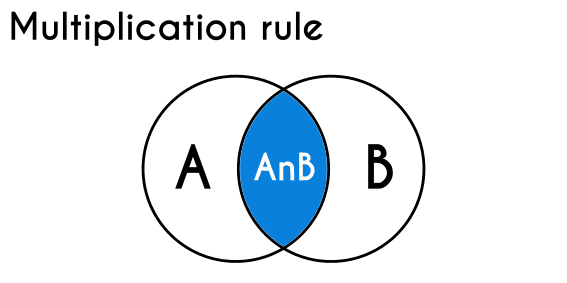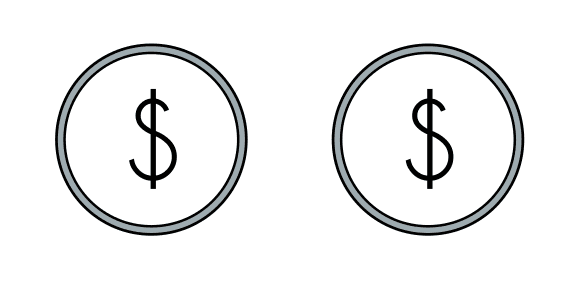The multiplication rule with Examples
This article will be about We will explain what is the multiplication rule and the cases that it can be used, with examples
What is the multiplication rule
The multiplication rules is a method that is used when we want to calculate the probability that 2 or more outcomes happen at the same time, using a Venn diagram to represent the probabilities could be a graphic way to show what are we looking for with the multiplication rule.

As we can see in the previous image the multiplication rule is used to calculate the intersection between 2 or more outcomes of the same sample space, this written mathematically would be “p(a n b)” that means the probability of “a” intersection “b”.
Scenarios in the multiplication rule
There are two scenarios where the multiplication rule can be used, one of them is when we are working with independent outcomes, this is when the occurrence of an outcome does not affect the probability of the other outcome, and the other scenario is when we are working with dependent outcomes, this is when we have two outcomes where the occurrence of the first one affects directly the probability of the second outcome. And for each scenario there is a different formula, therefore the way we solve problems will depend on what type of outcomes we are working with, this is why we first have to analyze the problem to know which formula is the most indicated for each case.
Dependent events: an example of this case is the next one: Two balls will be removed from a bucket which has inside of it 31 balls, which 5 balls are yellow, 9 are red and 17 are brown. If one of them is removed first and then the other one ¿What are the odds that the first ball is brown and the second one is yellow? In this case we are talking about a dependent event because when we remove the first ball the probability that this one is brown is 17/31, but when we remove the second one the probability changes because there are not 31 balls anymore because we already removed one, instead the probability would be 5/30, this means that the occurrence of the second event is affected by the first one.
Independent events: if an ice cream shop sells 2 types of ice cream, one of them is in cone and the other one is in a cup, and besides that there are 4 different types of ice cream: vanilla, pistachio, chocolate and strawberry. ¿What are the chances that when a person chooses one combination of ice cream this one picks the chocolate ice cream in a cup? As you can see here the flavor of the ice cream does not affect the presentation of it, therefore this are independent events.
Formulas of the Multiplication rule
In general in the multiplication rule problems is not that clear if we are going to be working with dependent or independent outcomes, this is normally defined by logic and analyzing the problem, so it is highly recommended to read the problem carefully to know what type of outcomes we are going to be working with, so we can pick the right formula.
There are two formulas in the multiplication rule, one for each type of outcome.
In the formula where the first outcome have effect with the probability of the second one there is the “p(b|a)” variable, this means “the probability of ´b´ when ‘a’ already happened”.
- Formula with independent events.
- p(a n b) = p(a) * p(b)
- Formula with dependent events.
- p(a n b) = p(a) * p(b | a)
Examples of the multiplication rule
Example 1: What are the chances that when we flip a coin this one lands on heads three times in a row.

- In this example we are going to use the independent event formula.
- p(a n b n c) = p(a) * p(b) * p(c)
- a, b and c are the probability of landing on heads.
- p(a n b n c) = 1/2 * 1/2 * 1/2
- p(a n b n c) = 1/8
- p(a n b n c) = 0.125 * 100%
- p(a n b n c) = 12.5%
Example 2: if in a group of 10 people there are going to distribute drinks of 10 different flavors and we know that one of the flavors is strawberry and other one is pineapple ¿What is the probability that the first one to be distributed is the pineapple drink and the second one is the strawberry drink?
p = pineapple, s= strawberry
- In this example we are going to use the dependent event formula
- p(p n s) = p(s) * p(p | s)
- p(p n s) = 1/10 * 1/9
- p(p n s) = 0.011 * 100%
- p(s n p) = 1.1%
Example 3: In a store they sell teddy bears and there are 30 teddy bears in stock, if half of them are brown and the other half are white, and according to the store statistics 4 of every 10 clients buy one teddy bear ¿What are the chances that the next client buy a teddy bear and the one that he picks is a white one?
B= buy a bear, W = white bear.
- Independent event formula
- p(b n w) = p(b) * p(2)
- p(b n w) = 4/10 * 1/2
- p(b n w) = 0.2 * 100%
- p(b n w) = 20%
Example 4: What are the chances that when we roll a dice it lands on the same side two times in a row.
A = probability of any side, B = probability that landed on the same side again.
- Fórmula de sucesos independientes
- p(a n b) = p(a) * p(b)
- p(a n b) = 1/6 * 1/6
- p(a n b) = 0.027 * 100%
- p(a n b) = 2.7%